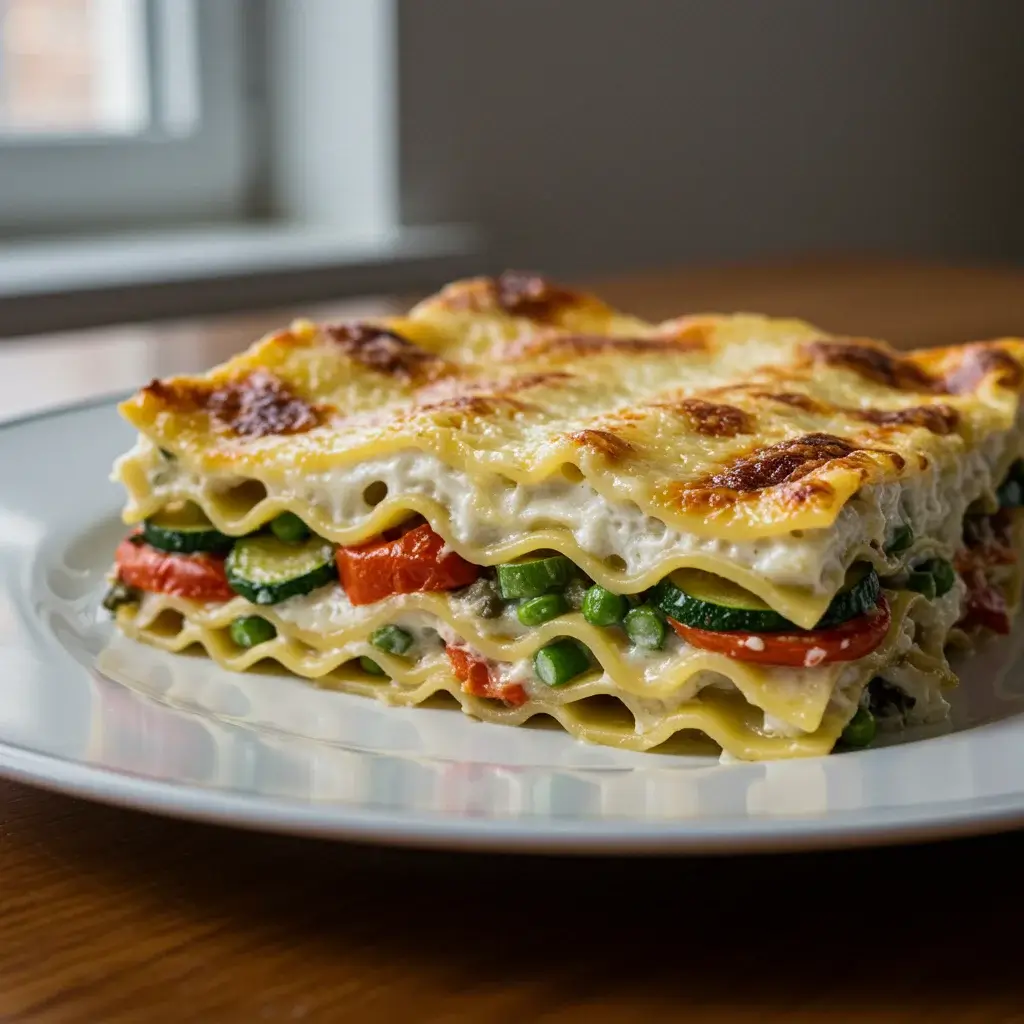Introduction
Vegetable lasagna with white sauce is a delightful twist on the traditional Italian dish, offering a creamy, savory experience that’s both comforting and nutritious. This version of lasagna layers tender pasta sheets with a medley of vibrant vegetables and a luscious béchamel sauce, creating a dish that’s perfect for family dinners, potlucks, or any occasion where you want to impress with a homemade meal. Not only is it delicious, but it’s also a great way to pack in a variety of vegetables, making it a healthier option for those looking to enjoy comfort food with a lighter touch.
In this article, we’ll guide you through the process of making vegetable lasagna with white sauce from scratch. You’ll find detailed instructions, nutritional information, serving suggestions, additional tips, answers to frequently asked questions, and more. Whether you’re a seasoned cook or a kitchen novice, you’ll find everything you need to create a mouthwatering lasagna that will have everyone coming back for seconds.
Ingredients
Before you start cooking, gather the following ingredients. Having everything ready will make the cooking process smoother and more enjoyable.
For the Béchamel Sauce
- 3 tablespoons unsalted butter
- 3 tablespoons all-purpose flour
- 3 cups whole milk
- Salt, to taste
- Freshly ground black pepper, to taste
- 1/4 teaspoon ground nutmeg
For the Vegetable Layer
- 2 tablespoons olive oil
- 1 large onion, chopped
- 3 cloves garlic, minced
- 1 red bell pepper, chopped
- 1 yellow bell pepper, chopped
- 1 zucchini, sliced
- 1 yellow squash, sliced
- 8 ounces mushrooms, sliced
- 1 cup fresh spinach leaves
- Salt and pepper, to taste
- 1 teaspoon dried Italian herbs (basil, oregano, thyme)
For the Lasagna Assembly
- 9 lasagna noodles
- 2 cups ricotta cheese
- 1 egg
- 2 cups mozzarella cheese, shredded
- 1 cup Parmesan cheese, grated
Instructions
Now that you have all your ingredients ready, let’s dive into the step-by-step process of making this delicious vegetable lasagna with white sauce.
Step 1: Prepare the Béchamel Sauce
- Melt Butter: In a medium saucepan, melt the butter over medium heat.
- Add Flour: Stir in the flour and cook for about 1 minute, until it forms a smooth paste.
- Add Milk: Gradually whisk in the milk, ensuring there are no lumps.
- Season: Add salt, pepper, and nutmeg, and continue to cook, stirring constantly, until the sauce thickens. This should take about 5-7 minutes.
- Set Aside: Remove from heat and set aside.
Step 2: Cook the Vegetables
- Heat Olive Oil: In a large skillet, heat the olive oil over medium heat.
- Sauté Onions and Garlic: Add the chopped onion and garlic, cooking until the onion becomes translucent.
- Add Bell Peppers: Stir in the red and yellow bell peppers, cooking for 2-3 minutes.
- Add Zucchini and Squash: Add the zucchini and yellow squash, and cook until they start to soften.
- Cook Mushrooms: Add the mushrooms and cook until they release their moisture and begin to brown.
- Add Spinach: Stir in the fresh spinach leaves, cooking until wilted.
- Season: Season the vegetables with salt, pepper, and dried Italian herbs. Remove from heat and set aside.
Step 3: Assemble the Lasagna
- Preheat Oven: Preheat your oven to 375°F (190°C).
- Boil Noodles: Cook the lasagna noodles according to package instructions. Drain and set aside.
- Mix Ricotta and Egg: In a bowl, combine the ricotta cheese and egg, mixing well.
- Layer Ingredients: In a 9×13 inch baking dish, spread a thin layer of béchamel sauce.
- Place 3 lasagna noodles over the sauce.
- Spread half of the ricotta mixture over the noodles.
- Add half of the sautéed vegetables.
- Sprinkle with one-third of the mozzarella cheese.
- Repeat layers: noodles, ricotta mixture, vegetables, béchamel, and mozzarella.
- Finish with the last layer of noodles, remaining béchamel sauce, and top with mozzarella and Parmesan cheese.
- Bake: Cover the dish with aluminum foil and bake for 25 minutes. Remove the foil and bake for an additional 15 minutes, or until the cheese is bubbly and golden brown.
- Rest: Allow the lasagna to rest for 10 minutes before slicing.
Nutrition Facts
Understanding the nutritional content of your meals is important for maintaining a balanced diet. Here’s an estimated nutritional breakdown for one serving of vegetable lasagna with white sauce (assuming the dish is divided into 8 servings):
- Calories: 450
- Protein: 20g
- Carbohydrates: 50g
- Dietary Fiber: 5g
- Sugars: 8g
- Calcium: 25% of the Daily Value (DV)
- Iron: 15% of the DV
Note: These values are approximate and can vary based on specific ingredients and portion sizes.
How to Serve
Vegetable lasagna with white sauce is a versatile and delightful dish that can elevate any dining experience. Its layers of rich flavors, creamy béchamel sauce, and hearty vegetables make it a satisfying centerpiece for a meal. To enhance the overall experience, consider the following serving suggestions that pair well with this delicious dish:
1. With a Side Salad
A crisp green salad is an excellent accompaniment to vegetable lasagna, as it adds a refreshing contrast to the dish’s creamy texture. Opt for a salad that incorporates a variety of textures and flavors. Here are a few ideas:
- Mixed Greens: Use a combination of arugula, spinach, and romaine for a base. Toss in some cherry tomatoes, cucumber slices, and radishes for crunch.
- Light Vinaigrette: A simple vinaigrette made from olive oil, lemon juice, Dijon mustard, and a touch of honey will enhance the freshness of the salad without overpowering it. Alternatively, a balsamic vinaigrette can add a tangy depth that complements the lasagna beautifully.
- Additions: Consider adding nuts like walnuts or almonds for crunch, or fruits like sliced apples or pears for sweetness. Cheese, such as feta or goat cheese, can also bring richness and balance to the salad.
2. Garlic Bread
Warm garlic bread or breadsticks are a classic pairing that not only adds a comforting element to your meal but also serves a practical purpose—sopping up any extra béchamel sauce from the lasagna. Here are some variations:
- Homemade Garlic Bread: Slice a baguette or ciabatta loaf, spread a mixture of softened butter, minced garlic, and chopped parsley on each slice, then toast in the oven until golden brown.
- Herbed Breadsticks: For a fun twist, serve herbed breadsticks with garlic butter. You can make these from scratch or purchase pre-made options from a bakery.
- Cheesy Garlic Bread: For those who love cheese, sprinkle shredded mozzarella or Parmesan on top of your garlic bread before toasting for an indulgent treat.
3. Wine Pairing
The right beverage can elevate your dining experience, and a glass of white wine pairs beautifully with the creamy béchamel sauce of vegetable lasagna. Here are two excellent options:
- Chardonnay: A full-bodied Chardonnay, especially one that has been lightly oaked, can offer a buttery richness that complements the lasagna’s creaminess. Look for a Chardonnay with notes of apple, pear, and a hint of vanilla to enhance the flavors of the dish.
- Sauvignon Blanc: For a crisper alternative, Sauvignon Blanc provides a refreshing acidity that cuts through the richness of the lasagna. Choose one that has citrus and herbal notes, which can echo the freshness of the vegetables in the dish.
4. Fresh Herbs
Garnishing your vegetable lasagna with fresh herbs not only enhances its aesthetic appeal but also adds an aromatic freshness that can brighten the flavors. Here are some herb suggestions:
- Basil: Fresh basil is a classic choice that pairs wonderfully with the creamy béchamel. Scatter whole basil leaves or finely chopped basil over the top just before serving.
- Parsley: Flat-leaf parsley adds a subtle earthiness and vibrant green color. Finely chop the parsley and sprinkle it over the lasagna for a fresh touch.
- Oregano or Thyme: For a more robust flavor, consider using fresh oregano or thyme, which can complement the vegetable layers beautifully. These herbs can be mixed into the béchamel sauce or used as a garnish.
5. Additional Sides and Garnishes
To create a more complete meal, consider serving your vegetable lasagna with additional sides:
- Roasted Vegetables: A medley of seasonal roasted vegetables, such as zucchini, bell peppers, and carrots, can add color and nutrition to your plate while echoing the vegetable theme of the lasagna.
- Seasoned Quinoa or Rice: A side of quinoa or rice, seasoned with herbs and lemon, can provide a hearty complement that balances the meal.
- Olives or Antipasto Platter: A small platter of olives, marinated artichokes, and roasted red peppers can add a Mediterranean flair to your dining experience.
By combining these serving suggestions, you can create a well-rounded meal that not only highlights the deliciousness of your vegetable lasagna with white sauce but also brings variety and excitement to your table. Whether it’s a family gathering or a casual dinner with friends, these enhancements will ensure an unforgettable dining experience.
Additional Tips
To ensure your vegetable lasagna with white sauce turns out perfectly every time, consider these additional tips:
Choose Fresh Vegetables
Using the freshest vegetables available is crucial for maximizing the flavor and texture of your dish. Fresh vegetables not only provide a vibrant taste but also contribute essential nutrients, enhancing the overall healthiness of your lasagna. Look for seasonal produce at local farmers’ markets or grocery stores, and select vegetables that are firm and free from blemishes. Ideal choices could include spinach, zucchini, bell peppers, mushrooms, and eggplant. Remember, the fresher the vegetables, the more they will retain their natural flavors during cooking.
Customize Your Veggies
Don’t hesitate to customize your vegetable selection based on your personal preferences or what’s in season. This dish is versatile, allowing you to incorporate a variety of vegetables according to what you have on hand. If you love a certain vegetable, such as kale or asparagus, feel free to add it to your layering. Conversely, if there’s a vegetable you’re not fond of, omit it or replace it with something you enjoy. Seasonal vegetables not only enhance flavor but also make your lasagna more visually appealing with a range of colors. Consider experimenting with roasted vegetables for an added depth of flavor, or sauté them beforehand to bring out their natural sweetness.
Make Ahead
One of the fantastic aspects of lasagna is that it can be easily prepared ahead of time. Assembling your lasagna a day in advance allows the flavors to meld beautifully, resulting in a more cohesive dish. To do this, layer your ingredients as you normally would, cover the assembled lasagna tightly with plastic wrap or aluminum foil, and refrigerate it. When you’re ready to serve, you can simply pop it in the oven, adjusting the baking time slightly if it’s going in cold from the fridge. This convenience is particularly beneficial for busy weeknights or when entertaining guests, as it allows you to focus on other aspects of your meal preparation.
Freezing Instructions
If you want to prepare your vegetable lasagna for future meals, freezing is a great option. This dish freezes remarkably well, making it an ideal candidate for meal prep. To freeze, ensure your lasagna is completely cooled after baking. Then, wrap it tightly in aluminum foil and place it in an airtight freezer-safe container or zip-top bag. It can be stored in the freezer for up to 3 months. When you’re ready to enjoy it, simply transfer the lasagna to the refrigerator to thaw overnight. Once thawed, you can bake it as you normally would, potentially adding a few extra minutes to the baking time to ensure it’s heated through thoroughly.
Non-Dairy Option
For those looking to create a dairy-free version of this delicious vegetable lasagna, there are several substitutes you can use that still result in a creamy and satisfying dish. When making the béchamel sauce, consider using almond milk or another non-dairy milk such as coconut or oat milk. Be sure to choose an unsweetened variety to maintain the savory flavor profile. For cheese alternatives, numerous vegan cheese products are available that melt well and provide a similar texture to traditional cheeses. Nutritional yeast is another excellent addition, offering a cheesy flavor without any dairy. This approach not only accommodates dietary restrictions but also allows everyone to enjoy a hearty serving of lasagna without compromising on taste or texture.
By following these additional tips, you’ll enhance your vegetable lasagna with white sauce, ensuring it is both delicious and accommodating to various preferences and dietary needs. Happy cooking!
FAQs
Can I use gluten-free noodles?
Yes, you can substitute regular lasagna noodles with gluten-free versions to accommodate dietary restrictions.
Can I add protein to this dish?
Certainly! Adding cooked chicken, turkey, or tofu can increase the protein content and add more depth to the dish.
What if I don’t have ricotta cheese?
Cottage cheese or a mixture of cream cheese and Greek yogurt can be used as alternatives to ricotta.
How long can I store leftovers?
Store leftovers in an airtight container in the refrigerator for up to 3-4 days. Reheat in the oven or microwave before serving.
Can I make this lasagna vegan?
Yes, by using vegan cheese, plant-based milk for the béchamel sauce, and omitting the egg in the ricotta mixture, you can make a delicious vegan version.
Conclusion
Vegetable lasagna with white sauce is a flavorful and nutritious dish that brings together the best of Italian cuisine with a healthy twist. By following this comprehensive guide, you’ll be able to create a lasagna that’s not only delicious but also packed with a variety of vegetables and creamy goodness. Whether you’re cooking for family, friends, or just yourself, this dish is sure to impress and satisfy.
Don’t hesitate to get creative with your vegetable choices and make this recipe your own. With its rich flavors and comforting textures, vegetable lasagna with white sauce is sure to become a favorite in your culinary repertoire. Enjoy your cooking journey and savor every bite!
Print
Vegetable Lasagna with White Sauce
Ingredients
Before you start cooking, gather the following ingredients. Having everything ready will make the cooking process smoother and more enjoyable.
For the Béchamel Sauce
- 3 tablespoons unsalted butter
- 3 tablespoons all-purpose flour
- 3 cups whole milk
- Salt, to taste
- Freshly ground black pepper, to taste
- 1/4 teaspoon ground nutmeg
For the Vegetable Layer
- 2 tablespoons olive oil
- 1 large onion, chopped
- 3 cloves garlic, minced
- 1 red bell pepper, chopped
- 1 yellow bell pepper, chopped
- 1 zucchini, sliced
- 1 yellow squash, sliced
- 8 ounces mushrooms, sliced
- 1 cup fresh spinach leaves
- Salt and pepper, to taste
- 1 teaspoon dried Italian herbs (basil, oregano, thyme)
For the Lasagna Assembly
- 9 lasagna noodles
- 2 cups ricotta cheese
- 1 egg
- 2 cups mozzarella cheese, shredded
- 1 cup Parmesan cheese, grated
Instructions
Now that you have all your ingredients ready, let’s dive into the step-by-step process of making this delicious vegetable lasagna with white sauce.
Step 1: Prepare the Béchamel Sauce
- Melt Butter: In a medium saucepan, melt the butter over medium heat.
- Add Flour: Stir in the flour and cook for about 1 minute, until it forms a smooth paste.
- Add Milk: Gradually whisk in the milk, ensuring there are no lumps.
- Season: Add salt, pepper, and nutmeg, and continue to cook, stirring constantly, until the sauce thickens. This should take about 5-7 minutes.
- Set Aside: Remove from heat and set aside.
Step 2: Cook the Vegetables
- Heat Olive Oil: In a large skillet, heat the olive oil over medium heat.
- Sauté Onions and Garlic: Add the chopped onion and garlic, cooking until the onion becomes translucent.
- Add Bell Peppers: Stir in the red and yellow bell peppers, cooking for 2-3 minutes.
- Add Zucchini and Squash: Add the zucchini and yellow squash, and cook until they start to soften.
- Cook Mushrooms: Add the mushrooms and cook until they release their moisture and begin to brown.
- Add Spinach: Stir in the fresh spinach leaves, cooking until wilted.
- Season: Season the vegetables with salt, pepper, and dried Italian herbs. Remove from heat and set aside.
Step 3: Assemble the Lasagna
- Preheat Oven: Preheat your oven to 375°F (190°C).
- Boil Noodles: Cook the lasagna noodles according to package instructions. Drain and set aside.
- Mix Ricotta and Egg: In a bowl, combine the ricotta cheese and egg, mixing well.
- Layer Ingredients: In a 9×13 inch baking dish, spread a thin layer of béchamel sauce.
- Place 3 lasagna noodles over the sauce.
- Spread half of the ricotta mixture over the noodles.
- Add half of the sautéed vegetables.
- Sprinkle with one-third of the mozzarella cheese.
- Repeat layers: noodles, ricotta mixture, vegetables, béchamel, and mozzarella.
- Finish with the last layer of noodles, remaining béchamel sauce, and top with mozzarella and Parmesan cheese.
- Bake: Cover the dish with aluminum foil and bake for 25 minutes. Remove the foil and bake for an additional 15 minutes, or until the cheese is bubbly and golden brown.
- Rest: Allow the lasagna to rest for 10 minutes before slicing.
Nutrition
- Serving Size: one normal portion
- Calories: 450
- Sugar: 8g
- Carbohydrates: 50g
- Fiber: 5g
- Protein: 20g






